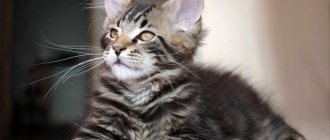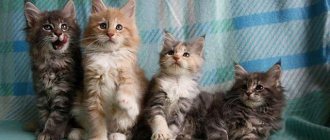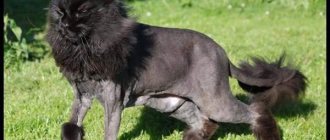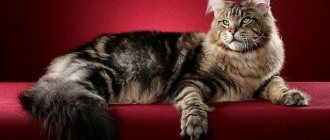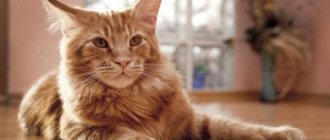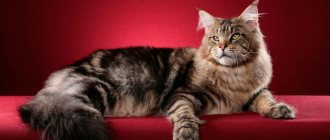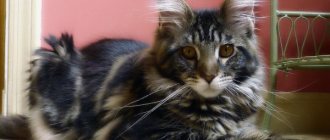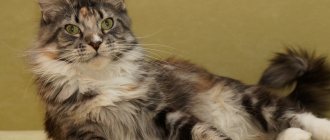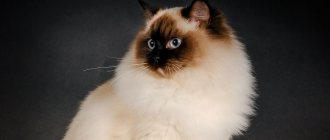Maine Coons have a bright appearance. Their luxurious coat, impressive size and powerful paws cannot go unnoticed. Inexperienced owners who are just planning to get such a pet may think that coons require special, labor-intensive care, but this is not the case. The main thing is to follow simple rules and know about the characteristics of representatives of this breed.
Before the kitten appears in the house
You should carefully prepare for the arrival of a kitten in your home. It is necessary to hide the wires, remove household chemicals, poisonous plants and small objects that the kitten may accidentally swallow. If there are small children in the family, they need to be prepared in advance for the arrival of the pet so that the kids do not accidentally harm it. You should also purchase:
- bowls for food and water;
- feed;
- tray and filler;
- combs, shampoos;
- scratching post and nail clipper;
- carrying - a backpack;
- house or bed;
- toys.
All care and maintenance products should be purchased immediately based on an adult animal - Maine Coons do not like change.
Character, intelligence, habits and habits of Maine Coons
It's "mainstream" to praise the impressive size of Maine coon cats, but the real beauty of this breed lies in their amazing intelligence and character.
Intelligence
In terms of intelligence, Maine Coons are not like most other breeds - they understand commands very well, are able to remember many words, and are sensitive to the intonations and emotional state of their owners; They take completely conscious actions and adapt to the rhythm of life, habits and daily routine of their owners.
They can perceive and interpret even human body language - gestures, looks and sounds. Their body language is also developed. Thus, a slight blow to the head means a particularly reverent attitude. Moreover, they communicate with humans, literally. In the communication arsenal of coons there is not only the usual meow, but also a wide range of other sounds that are completely atypical for cats - a kind of chirping, various squeaks, trills and many variations of purring.
The behavior of Maine cats directly depends on the quality of their upbringing.
Character
The key character traits of Maine Coons are neatness, peacefulness and calmness. They are not at all prone to mischief, knocking over things, or doing something out of spite. Thanks to their developed intellect, they are well aware of the boundaries of what is permitted and do not cross them.
It is generally accepted that cats view everything around them as their property. But in this sense, the Coons are an enviable exception - they divide all objects into theirs and those of others, treating the latter very carefully.
Maine cats generally behave very carefully. They do not like to climb cabinets or mezzanines, preferring to lie on the sofa or carpet. They prefer open spaces; like all predators, they instinctively strive to occupy some elevation in order to observe what is happening around them.
Maine Coons behave in many ways like dogs.
Peculiarities
These animals are very fond of water procedures in any of their manifestations. Bathing for a Maine Coon is a real holiday. This is worth remembering if you have an aquarium or other open containers of water.
Maine Coons are natural hunters, so all foreign animals within their reach will be caught, strangled and, most likely, eaten. At the same time, they are smart enough to realize the presence of other pets and not offend them, even birds and fish.
Cats of this breed are very playful, but they need a partner to play. If you have one cat, you should regularly play with him or at least allow him to spend time with you. They do not tolerate loneliness well, so it is worth making sure that the animal has something to occupy itself with, fortunately, many different toys are sold today.
A lively mind provokes a very developed curiosity in Maine Coons. If you live in a private house and let your cat out for walks, keep in mind that excessive curiosity can lead to dire consequences. And I can simply steal such a noticeable animal - you shouldn’t forget about that either.
With their love of water, Maine Coons are radically different from all other cats.
Socialization
Cats get used to their owner very quickly. They carefully study their person, adapt to the characteristics of his behavior, and learn to understand him. They single out one “main” person, but easily accept other family members and pets.
Maine Coons have a clear “friend or foe” division - they ignore and even avoid strangers who come into the house. However, after several meetings, “acquaintance” does occur, especially if the new person does not try to touch the cat. Representatives of this breed generally do not like to be picked up or placed on laps. Although these behavioral reactions may be different if the coon is accustomed to being on your hands or knees as a child. And sometimes animals themselves feel a desire to get closer to a loved one, but this still does not apply to unfamiliar people.
Maine Coons love children, take care of them and even tolerate children's pranks. It is still better to explain to the child that the kitty is alive, it may be unpleasant for her, she may defend herself. But often such problems do not arise - developed intelligence allows the kun to “forgive” a child much of what would be unforgivable for an adult.
By the way, Maine Coon males are excellent dads. They take a direct part in raising the offspring - they are not separated even from newborn kittens. Perhaps this is why they are lenient towards human cubs.
Maine Coons are highly social animals.
Rules of courtship
Maine Coon care is a set of hygiene procedures aimed at maintaining not only a beautiful appearance, but also good health of the pet.
Ears
Ear care involves cleaning the ears from accumulated wax using cotton swabs. The use of water or any preparations to clean the ears is prohibited without consulting a veterinarian. It is allowed to treat the inner surface of the ear with antiseptic powder in order to prevent ear mites.
Eyes
A healthy pet should not have mucous accumulation in the corners of the eyes. If they appear, you need to remove them by wiping the Maine Coon's eyes with a cotton pad soaked in tea, chamomile infusion or boric acid solution. Wiping must be repeated daily until the discharge stops accumulating.
If after several days the situation does not change, you should show the animal to a doctor.
Muzzle
The Maine Coon's face does not require special care, but the appearance can be spoiled by crusts that sometimes form in the corners of the nostrils, but they can be easily removed with a cotton swab dipped in boiled water. Also, exhibition grooming involves cutting the so-called smile, i.e. thinning the hair around the mouth.
Teeth and gums
Coons are prone to the formation of tartar, so it is necessary to monitor and care for the condition of the cat's oral cavity. If the cat’s diet is based on dry food, which helps clean the teeth and form a correct bite, you should brush your pet’s teeth yourself once every 2 months; if feeding natural products, monthly. For cleaning, use a children's toothbrush and special toothpaste.
Paws
Most often, tangles form on the paws. This occurs due to particles of filler, feces and urine getting into the wool. That is why the limbs of coons require the most careful care and regular combing.
Nail care technique
As a rule, Maine Coons grind their claws down on their own using a scratching post; if this does not happen, they need to be shortened with a nail clipper 1-2 times a month. It's important to do it right:
- take the paw pad from below with your index finger, and with your thumb grab the skin above the claw, lightly pull it and squeeze your fingers - this way the claw will come out;
- examine the claw through the light to see where the vessel passes;
- carefully cut the claw across the plate, because increases when trimmed lengthwise
- risk of damaging blood vessels;
- if the claw is pigmented and the vessels cannot be seen, when trimming it is necessary
- leave a reserve;
- File the sharp edge with a nail file.
If blood vessels were damaged during the procedure, it is necessary to treat the wound with an antiseptic. If there is severe bleeding, apply a tight bandage to your pet's paw and contact a veterinarian.
Rules of care
During the first two weeks after the cat comes to your home, experts do not recommend performing any procedures other than basic ones, as this can bring additional stress to the animal. The exception is brushing and, if necessary, bathing.
Necessary items and accessories
You can quench your cats' thirst for games with any toy. It doesn't matter what exactly it will be. You can, for example, use a regular rubber ball. Maine Coons love to play with him, chasing him around the house for elusive fun.
Important! It is necessary for cats to have their own scratching post in the house. When choosing a scratching post, you need to ensure that cats should stretch to their full height while they sharpen their claws
In addition to being long, these devices must also be durable to withstand heavy weight.
As a standard, the cat must have its own bowls (for water and food) and a tray. It's better if it's closed. Bowls must be durable, since it is likely that a strong animal will start playing with it, rolling around on the floor
When choosing a scratching post, you need to ensure that cats should stretch to their full height while they sharpen their claws. In addition to being long, these devices must also be durable to withstand heavy weight.
As a standard, the cat must have its own bowls (for water and food) and a tray. It's better if it's closed. Bowls must be durable, since it is likely that a strong animal will start playing with it, rolling it around on the floor.
Bathing, brushing and other procedures
About caring for the Mei-Coon breed (another version of their name, although not entirely correct), we can say that it is not so complicated. The wool is silk, so it hardly tangles and does not require frequent combing. Once a week is quite enough.
Close attention to combing should be paid during a certain period in spring and autumn, when the period of active molting begins. Did you know? Maine Coons began to lose their great popularity with the arrival of Persian cats in 1900.
Did you know? Maine Coons began to lose their great popularity with the arrival of Persian cats in 1900.
An important procedure for caring for an animal is bathing. First of all, the signal that it’s time to bathe the cat will be the detection of stains and any dirt on the cat’s fur.
Bathing should be done with a special shampoo. It is better if you purchase it from a veterinary clinic.
In addition, it is necessary to carry out water procedures when fleas are found on the animal’s body. For this you should also purchase specialized medications. In other cases, Maine Coon should not be bathed. He can easily monitor his cleanliness by licking his fur.
Exceptions are cases when (if) you are preparing your pet for an exhibition and want to give its coat a certain style.
Important! If there is no special need (the fur is not dirty), then you need to bathe the Maine Coon no more than once every 3 months.
It is highly not recommended to bathe cats before and after vaccination, after suffering from any disease, and immediately after moving. The fact is that during bathing the animal experiences discomfort, which can lead to stress.
In addition to the above factors, the Maine Coon can experience very strong stress, and this in turn will lead to a decrease in immunity.
Scratching posts
A scratching post is necessary not only to protect furniture from damage, but also to maintain the health of your pet. Too long nails can cause curled nails, discomfort when walking and, as a result, lameness, sprained ligaments, painful cracks and chipped nails. Scratching posts can be:
- wall - planks covered with sisal rope or canvas;
- floor - sisal rugs lying on the floor;
- free-standing - posts wrapped in sisal rope and standing on a wide, round base.
It is believed that wall-mounted scratching posts and posts are better for coons.
How to train?
After the cat wakes up, you need to pick him up and take him to the scratching post. First, he should sniff it and calm down, then, supporting the pet, you should run the pads of his paws along the scratching post. This needs to be repeated several times, then praise and pet the pet.
Wool
Maine Coons have semi-long coats; maintaining a healthy shine and silkiness requires some effort.
Coat care should begin with examining your pet for any tangles that have formed.
If there are tangles, they must be carefully untangled or cut off. To prevent matting of the coat in the future, the Coons should be combed at least 2 times a week, first with a wide-tooth comb, then with a fine-tooth comb, and then comb the coat with a massage brush with natural bristles - this helps get rid of the maximum amount of lost hair.
First of all, you should comb the tail, then the back, chest and sides, and at the very end - the “pants” and belly. Representatives of this breed shed twice a year. At this time, you need to comb your pet more often, preferably daily. You can additionally use a powder brush.
All combs should be metal so that the pet’s fur does not become electrified, and have rounded teeth so as not to scratch the cat’s skin.
How long do Maine Coon cats live?
The lifespan of a Maine Coon also depends on proper care and nutrition. A healthy lifestyle can give an animal 12-15 years, but there are also centenarians who are 20-22 years old.
Note! One of the features of the breed is that females live approximately 1-1.5 times longer than males. As you can understand from the article, the Maine Coon is a rather demanding breed of cat.
The owner will have to choose the right diet for the pet, brush its thick, long hair daily, and undergo regular checkups with a doctor. However, if a person decides to get a smart, kind, and most importantly, incredibly beautiful animal, then it is best to choose a Maine Coon
As you can understand from the article, the Maine Coon is a rather demanding breed of cat. The owner will have to choose the right diet for the pet, brush its thick, long hair daily, and undergo regular checkups with a doctor. However, if a person decides to get a smart, kind, and most importantly, incredibly beautiful animal, then it is best to choose a Maine Coon.
Types of cat houses
The range of cat houses in stores is quite large; it can be difficult for an inexperienced coon owner to choose the right option for his pet. It could be:
- a hammock that can be secured on 4 sides almost anywhere, even under a chair;
- a house in the form of a booth, which is a fabric-upholstered structure with a roof;
- cardboard house of any kind - such products look original, but are not practical.
Also popular are smaller copies of home furniture - beds and sofas for cats.
Beds
One of the simplest options for a cat house. Essentially, it is a thick mattress covered with fabric that can be removed and washed if necessary. Beds can be round, square, rectangular, heart-shaped, etc. It is important that the size of the bed matches the size of an adult cat.
Carrying
There are several types of carriers:
- bag - a carrier made of lightweight fabric with a frame, thick walls and a mesh that allows air to pass through, some models are equipped with small windows;
- a backpack is the most convenient option for travelers, since the owner’s hands remain free;
- plastic container - a stable, ventilated design that is easy to clean;
- cage – designed for transporting cats in transport and is a stable, durable, well-ventilated metal structure.
It is best to have several types of carriers, since each of them is convenient for some purposes and not for others.
Game complexes
These are three-dimensional structures that include everything that a Maine Coon needs for a comfortable life and development: loopholes, stairs, hammocks, a house, scratching posts, toys, etc. Play complexes are a good way to provide your pet with everything necessary and organize his leisure time, but you should understand that they take up a lot of space and are not suitable for installation in a small apartment.
Toys
All toys for Maine Coons can be divided into several categories:
- balls, mice and other toys that the cat rolls on the floor - it is important that they do not contain small parts;
- so-called teasers - the cat can play with them only in the presence of the owner, since they have feathers or small balls that the coon can tear off and swallow;
- Interactive is the best option for Coons, promoting their development and helping them tolerate loneliness more easily.
It is important to choose high-quality toys that do not contain toxic substances.
Animal growth
Maine Coon mixed breed - a mixture with a regular cat
Up to one year of age, kittens develop quite rapidly. By three months, the baby already exceeds the performance of some adult cats of ordinary breeds. In general, the size of a pet depends on many factors.
Important! You should not be upset if the animal does not meet the development standards, but you should still be careful. There is always the possibility that the breeder sold a crossbreed instead of a purebred Maine Coon. When choosing an animal for your family, it is best to contact an official nursery.
Height
Toilet and tray training
It is necessary to monitor the pet and its behavior.
If he moves restlessly, tries to find a secluded place, meows, then these may be signs that the cat wants to go to the toilet.
You need to carefully pick up the coon, take him to the tray and put him in it, not allowing him to leave until he goes to the toilet. You should also take your pet to the toilet after sleeping and eating. It is necessary to ensure that the tray is clean - strong unpleasant odors repel animals.
During the first month, you can limit the pet’s space, leaving him with a minimum of opportunities to relieve himself in the wrong place. If a puddle is still noticed outside the tray, you should blot it with a napkin, which should then be placed in the tray - this smell will attract the cat and indicate to him the correct place for the toilet.
You cannot scold or physically punish a cat - this will only scare it away.
Water treatments
Representatives of this breed require a complete wash every 2-3 months; urgent bathing is possible in case of heavy soiling, before a show and during shedding. You need to bathe your pet as follows:
- Fill a sink or basin with warm (at least 38 ℃) water, lay a towel or rubber mat on the bottom so that the cat’s paws do not slip;
- holding the coon by the scruff of the neck, wet his fur with a sponge and smoothly, without allowing the fur to mat, rub in the shampoo, moving from the back to the tail;
- Wash your hair without shampoo, making sure that water and detergent do not get into the eyes, ears and mouth of the cat;
- rinse the hair under low pressure from the shower, rinsing off all the shampoo, otherwise its residue may lead to skin irritation;
- apply the balm and rinse it off;
- blot, but do not rub, the wool with a towel;
- dry your pet with a hairdryer.
After bathing, the cat needs to be combed, paying special attention to the hair on the belly and “pants”.
To make the collar more magnificent, you need to comb it from the bottom up; you should not comb the tail.
Coat care may include deep cleansing shampoos and cosmetics aimed at nourishing, moisturizing and adding volume to the coat. It is possible to use medicinal shampoos - strengthening, fighting hair loss, seborrhea or skin diseases. There are also hypoallergenic products and cosmetics intended for kittens.
For Maine Coon care at home, products from the brands Goop, Jerob, All Sistem, Gimpet, Anju, Bio-Groom and others are suitable - their range allows you to select products taking into account the quality and color of the coat.
AK Bars
On April 14, 2012, the grooming salon “White Wolf” hosted a seminar by Natalia Samoilova, a well-known groomer and coon breeder in the cat world.
Many thanks to Svetlana Pavlova for photo support of the seminar.
I bring to your attention her article, written based on the materials of the seminar. The title of the topic “Brief summary of the grooming seminar” reflects its essence. This is exactly a BRIEF and exactly a CONSPECT through the eyes and hands of one of the participants. Nuances and many quite important points are not reflected here. 10 hours of intense joint work is difficult to reflect in a short article. I kindly ask you to take this into account and for all the complete information, contact the primary source - Natalia Samoilova. Believe me, everyone is interested in the best grooming results, and the best groomer for a coon is HIS OWNER!
The first part, theoretical, included many topics. And the structure of the skin, and the characteristics of the content, and behavioral aspects, and the properties of products of different brands used for grooming. At this time, the hero of the day - Cross Kocurro (Miwa's maternal uncle) was patiently waiting in the tent for his exit.
“Yes, I am a shoemaker without boots! – Natalya laughs. – Russia should have been washed two months ago, but I didn’t have time. He has already begun to shed, tangles have formed here and there, and his tail has become thoroughly greasy. But I can show you how to work with tangles and very oily hair.”
As a result of the collective meeting, a whole arsenal of cleaning products for Rus' was chosen. To degrease the tail, we prepared Jerob Pre-Cleansing Creme, for the body - Groomer's Goop gel, as the first shampoo - Jerob One Step Grease Removing Shampoo, for texturizing - Jerob Texturizing Shampoo, and to emphasize the color - a whole set of tinted shampoos from the Jerob and Anju line Beauty.
The first stage is preparation for washing, basic degreasing. First, let's take care of the tail: using a hair coloring brush, apply Jerob cream to the upper part of the tail - where the guard hair grows. It is applied to dry wool. It is important to work the fur all the way down to the skin - otherwise you won't be able to rinse the tail properly - and all the way to the end of the tail, not just the first third. This stage is necessary not only for breeding cats, in which the fatty tail is obvious, but also for cats and kittens, although to a lesser extent - the tail begins to become greasy from four months. You can also use Groomer's Goop paste to degrease the tail - it works the same way, but is somewhat thicker and requires more consumption.
Then, using the same product, without rubbing it into the roots, we treat the area behind the ears,
collar.
Using Groomer's Goop gel we treat the fur along the body. This will help us wet the coat faster and prepare it for the effects of degreasing shampoo.
Prepare all the products in advance so that you do not have to run out of the bathroom in search of a forgotten shampoo, conditioner or towel.
Everyone knows how difficult it is to wash a cat - especially one as large as a coon - alone. Few people stand humbly and wait for the procedures to end. I always want to grow myself a third arm! An excellent solution is a rubber harness with a carabiner on a suction cup. The suction cup is very powerful, holds perfectly on any smooth surface - but in no case is it corrugated! - surface, and allows you to keep even the most obstinate cat within the bathtub.
In the meantime, several minutes have passed, which are necessary for the degreasing pastes to act. We wash them off with warm water - about 37–38.5 degrees. Yes, the cat is shaking! But you shouldn’t give him a steam room - just make sure that the bathroom is warm and there are no drafts.
The first rule of good grooming is to thoroughly degrease the coat!
Don't forget that we have an area behind the ears, and there is also hair growing on the head that needs to be washed. Otherwise, we will get a clean cat with a fat “mohawk” on the forehead - and this will ruin the whole impression of the most thorough and luxurious grooming!
We fold the ear so that no water gets in there, and wet the fur wherever necessary.
Now take a degreasing shampoo and apply it to the wool. Natalia does not use shampoo solutions, preferring to first rub them in her palms and then apply. Rub the shampoo into the tail especially carefully.
Don't forget the hind legs, including the knees and heels,
and front ones. Natalya uses a soft brush for her paws.
For the entire body - a rubber pad for combing out wool.
This is another option for distributing shampoo. It is important to thoroughly massage the entire coat down to the base so that we do not end up with unwashed roots. Otherwise, we will get a luxurious cat immediately after washing, but the next morning all the fur will form icicles again.
The shampoo is applied with soft massage movements along the hair growth. Do not make random movements against the wool - otherwise it may become tangled during washing. In addition, with sudden movements against the hair, microtraumas of the muscles located deep in the skin and raising the hair are possible. As you understand, even if they are not visible, this still does not affect the condition and appearance in the best way.
I had to wash Russia three times with degreasing shampoo. If the cat is washed regularly, then, as a rule, once is enough. How much to lather is up to you to decide. The clean wool creaks to the touch under your hand.
At the second stage, Natalya uses texture shampoo. The usual procedure for using products is slightly different: degreasing, coloring, texturing, conditioning. But she swaps the second and third stages. Again, this depends on personal experience and the range of products used.
After the texture shampoo, we start experimenting with color - the fact is that we chose three different tinted shampoos for the sides of the cat and the tail! And the fourth - Anju Beaute Blancheur - for the white areas of the coat.
We apply the shampoos to the coat—again, rubbing in thoroughly—and set the hourglass for six minutes. Looking ahead: of course, we did not notice a pronounced effect from different tint shampoos - rather, a tendency to treat wool in one direction or another, because all these shampoos, including whitening, have a cumulative effect. Hence another rule of grooming - regularity! Only then will you get the desired result.
Have you ever thought why a groomer needs wristbands? Uncomfortable, do they get wet? But your hands will be intact! A cat can wash himself perfectly a thousand times, and on the thousandth time he can break something off. So don't let yourself relax for a minute! Talk to your cat the entire time you are washing him in a calm, confident voice. Praise for correct behavior, do not pay attention to frills - scolding the cat during the procedure is unacceptable!
And before washing, it’s better to cut your cat’s claws...
The last stage is conditioning. If degreasing cleanses the hair, opening it up and preparing it for the perception of care products, tinted shampoos, texturing restores the structure of the hair, “reinforcing” it with keratin, then the conditioner returns the lubricant to the hair, which we previously completely removed from the hair, closes the cuticle of the hair, making it smooth again and impermeable to external influences. Without conditioner, the hair is defenseless, and if it seems to you that it weighs down the hair, “lays it down” and makes it greasy, there may be two reasons for this. The first is that the air conditioner is chosen incorrectly. The second is that the conditioner is poorly washed off. The last rinse of the wool should be the most thorough, and you should feel with your hands that the wool is perfectly clean, rinsed until it is squeaky clean.
To give your Maine Coon a beautiful coat, add a drop of Pet Silk liquid silk to a portion of the conditioner and distribute it over the top coat. Treat the rest of the body with conditioner without additives.
The entire coat must be treated with conditioner to its full depth, including the heels and head - after all, we need to close the hair cuticle everywhere! Act quickly - you don't need to leave conditioner on the wool for show effect.
At the last stage of washing, we make the water cooler - this also helps us close the hair.
Having removed excess water from the wool, blot it with a towel, as if squeezing the wool. You can't rub or ruffle it! The better the absorbent properties of a towel, the more beneficial it is for us. Natalya’s towel is magical: it absorbs water, then you can wring it almost dry and dry the cat again. It feels like porous rubber to the touch. Those who don’t have such a magical thing will have to change several towels.
We wrap the cat in a large terry towel and sit with him for several minutes.
It turns out that wrapping a big cat in a big towel is very simple! And in this way we immediately protect ourselves from his long and clawed paws swinging in all directions (even if the claws are trimmed, the paws do not cease to be clawed!).
Cover the cat from above.
We stretch the front corner of the towel under the cat's belly.
The front corner on the other side will cover the cat's front paws.
We connect these corners behind the cat's back.
Washed and wrapped in a towel. By the way, it will be very good if it turns out to be warm - from a radiator or from a heated towel rail.
“The basis of grooming is health,” says Natalya. — No cosmetics will help a cat look good if he doesn’t feel well. By grooming we can only emphasize the natural beauty of the animal. Clean the skin and fur, show the cat as it would be in natural conditions. After all, our houses and apartments are unnatural conditions for a cat’s life, and it’s no secret that animals that have the opportunity to go outside and walk in an enclosure look much better than those locked within four walls.”
Dust, static electricity, central heating - all this has a negative effect on wool. Therefore, grooming and washing are necessary for cats. And not only for those who exhibit. After all, it’s nice to have a beautiful cat walking around the house - and the cat itself will feel better when its fur and skin are clean and well-groomed. Therefore, regular washing - depending on the condition of the coat, once every six months or three to four months - is recommended for everyone, including pets.
On the other hand, if a cat’s fur quickly loses its well-groomed appearance, despite the most correct and thorough washing, this is a signal to check its health.
Meanwhile, Rusya, after sitting in a towel, was again placed on the grooming table to continue the master class.
Before blow-drying your cat, comb the fur everywhere - along the body, on the paws, on the chest and armpits, on the tail and in the groin.
Sometimes tangles form during washing - the hair that falls out gets tangled. Before the main drying, they must be disassembled and combed. The “drop” tangle cutter does this better than others: the sharp end is used to pry up the tangle and the blade is used to cut it, if necessary, repeatedly. The remaining tangles can be easily combed out with a comb.
If we are talking about exhibition grooming, then we cannot do without a hairdryer. But not all cats take it calmly. Therefore, when turning on the hair dryer, keep it as far away from the cat as possible, pointing it in the opposite direction. And keep the cat. Gradually bring the hair dryer closer and monitor the reaction.
An important part of being a groomer is the right balance of confidence and caution. You can agree on good behavior with any cat - but just in case, look for a place where you can throw a hairdryer without consequences if the client breaks out.
There are several ways to dry a cat. For example, on the table. Hold the cat with one hand, a comb in the other, and a hairdryer in the third. Perhaps, with the development of human society, a new race will arise - three-armed groomers... but who knows, there are still many cases in life when a third hand would be very useful? In the meantime, we have to use various tricks.
But if you have an assistant, then the work is much easier and more convenient. The groomer places the cat on his lap, and the assistant holds the hairdryer.
Sometimes you have to put a towel collar around the cat’s neck because the client already has a plan in his head to immediately run away. First, we press the cat with our hand, and, again talking confidently with him, we begin to comb.
We start drying with pants.
Since pants tend to curl, we press the wool against the body and release it from under the hand in small strands, pulling it out under a hairdryer.
Depending on the length of the cat’s fur, we use the comb differently. If you need to raise the hair, then we work against the growth; if you visually lengthen it, then we direct the main movements according to the growth of the hair: one towards you, two away from you. In this case, the hair dryer blows against the grain. The assistant guides the hair dryer following the comb in an even motion—there is no need to turn the nozzle to the sides.
We continue to dry the body. We leave the tail for later. If the tail is dried first, then the cat has the opportunity to waste all your efforts, well, you understand where: let’s say he wants to hold the tail between his wet paws or lay it on his wet side.
If the cat does not allow us to turn itself belly up, there is always the opportunity to tighten the skin and dry the belly while the cat lies on its side. The same goes for the inner surface of the paws.
The tail is dried with a slicker, moving against the grain, in a spiral from base to tip. Of course, you can try to dry first one side of the tail, then the other - but it is possible that we will get an asymmetrical tail or some areas will not be covered.
I always thought that a slicker was useless for grooming cats. Maybe with the exception of the Persians. Because I saw only completely amateurish use of this tool in the hands of owners of a wide variety of animals, with different lengths and different quality of fur. Then I saw its use on dogs, namely Bichons. However, I couldn’t even think that this tool would also be useful for cats. And for the tail, the main advantage of the slicker is used - it works with the entire surface, capturing and guiding the hair. The main thing is to avoid chaotic movements, otherwise the fur may become tangled. How to distinguish a garbage slicker, which you can’t even approach a cat with, from a professional tool is in the third part of the summary.
Don't forget about the tip of the tail. The cat must be beautiful throughout its entire length!
It is most convenient to comb furry heels with a small comb, which is sold in pet stores for combing out fleas. I don’t know how many fleas it can comb out - they jump faster - but it works on areas with short hair “excellently”.
Then we start drying the collar
and belly. These areas take a long time to dry, and the direction of wool growth is different. But since this is our suspension and decorative hair, we need to dry it thoroughly, stretching it and not letting it curl.
How do you know if an area of fur is dry? Firstly, by eye, and secondly, by the movement of the comb. The comb passes through dry wool easily and unhindered, but slows down on wet wool. Well-dried and combed fur on hand should resemble the look of a Russian field when the wind blows across it.
Follow the assistant! It is known that you can endlessly look at three things: how the fire burns, how the water flows and how the cat’s fur moves under the hairdryer. The assistant can go into a trance and switch off! It happens that even a cat falls asleep under a hairdryer - but he can.
If the cat stubbornly does not want to dry it with a hairdryer, then the same drying and combing technology is used, only we will have to periodically catch the cat and comb it, breaking the damp strands. If you let the cat dry completely on its own, then its curly pants and strands of fur will become fixed - and this is not at all what we need. Really, it’s easier to reconcile a cat with a hairdryer!
Natalia works in an apron. Grooming is an energy-consuming and sweaty job, and the apron serves not so much to protect the groomer from the cat, but rather the other way around - to prevent moisture from the body of a rotten person from spoiling the result of the work.
After the cat is dried, we put it on the table and critically look at the result of our labors. We remember the Maine Coon breed standard and bring the coat in line with it using styling products.
While the fur is still slightly damp, you can rub a drop of Pet Silk liquid silk in your hands and apply it to the cat’s coat - the hair is not yet completely closed and will accept this product. We will get a smooth, shiny top coat, which is what we need.
With the help of a texturizer and a hairdryer, we can style the wool in the direction we want: to emphasize the collar or, conversely, to smooth it. Unfortunately, it is difficult to describe this in words - such subtleties are transmitted from hand to hand or through video. In any case, try to use a minimum of products and not overload the wool.
If some area was dried incorrectly - for example, somewhere you forgot to “stretch” your pants and curls formed, just moisten the wool with water and dry it again.
The next article will cover the last stage of grooming: touches before the show, correcting mistakes, correcting coat and color, as well as tools.
Source: Maine Coon portal
Groomer: N. Samoilova, Maine Coon breeder, Riddlecoon kennel, Moscow
Author of the material: S. Pavlova (Usataya), Maine Coon breeder, Megatherion kennel, Moscow
Professional bathing set
For the exhibition, I wash cats with the professional JEROB series.
shampoo and conditioner for home use
I highly recommend this series of shampoo + conditioner. I like the quality of the wool after use. The most important thing is to use only in pairs. Fasten the cat onto a special suction cup to the bottom of the bathtub. Reassure the animal in a gentle voice. The water tap must be opened in advance and switched to the shower. If you do this abruptly, you may scare the animal. First, I wash it with any budget shampoo, twice. Afterwards I apply Royal Groom shampoo, rub it well into the fur, massage with a rubber mitt or a medium-hard brush. I rinse and apply conditioner balm with protein and mink oil or volume and elasticity conditioner balm for long-haired cats. Wrap it in a towel and sit with the kitten for about five minutes, let it calm down. Then comb it. If it’s cold at home, I close the kitten in a plastic carrier and direct slightly warm (not hot!) air from the fan heater from a distance of 30-50 cm inside. After 30 minutes we take out a clean and dry cat. The most important!!!! control time and temperature.
I put cats in this carrier to dry them
Nutrition - what and how to feed?
Industrial food and natural products are suitable for feeding Maine Coons; the main thing is not to mix both types of feeding and ensure that the diet is balanced. When feeding prepared foods, preference should be given to premium and super premium products. The most popular food brands are Royal Canin, Eagle Pack, Hills, Nutro, Eukanuba - their range includes food designed specifically for Maine Coons. Natural nutrition should consist of 70 - 80% meat products, the remaining 20 - 30% is allocated to cereals, vegetables, dairy products, etc. The menu must include:
- veal;
- beef and beef by-products;
- chicken and chicken by-products;
- eggs;
- porridge;
- vegetables;
- dairy products;
- seafood other than fish;
- greens and vitamins.
Maine Coons with light coats can be given liver no more than 2 times a week, otherwise the coat color may change.
You cannot feed your pet:
- canned food intended for people;
- smoked meats, pickles, sweets, spices;
- pork;
- duck;
- legumes;
- potatoes.
Also, your pet should always have access to drinking water. Since the time of living in the wild, representatives of this breed have retained the habit of “digging” water before drinking in order to clear it of leaves and branches that have fallen into the reservoir. Therefore, you should carefully consider the choice of bowls for water and food - the dishes should be heavy enough or attached to the floor so that the cat cannot knock them over or move them.
Kittens
| Age | Diet | Number of feedings |
| 1 month | The basis is mother's milk, a milk substitute, scraped, pre-frozen beef, and liquid porridge are gradually introduced | 8 |
| 2 months | It is necessary to reduce the amount of bait porridge and milk, increasing the amount of meat. Food volume – 120 – 150 g per day | 6 |
| 3 - 4 months | If you plan to feed your kitten with ready-made food in the future, you should decide on the brand and feed it in accordance with the directions on the package. In the case of natural nutrition, it should be based on boiled or steamed meat. Amount of food – 180 – 200 g per day | 4 |
| 6 – 12 months | Gradually transfer your pet to the diet of an adult cat, increasing the serving size to 200 - 250 g per day, of which meat should be at least 40 g | 3, closer to a year – 2 |
Breed content
The Maine Coon is a big cat, hence the maintenance costs.
Maine Coon food
From an early age, a pet should not be fed only dry food - it will not grow large. The Maine Coon's diet should include:
- premium/super-premium food;
- quality milk;
- low-fat beef, chicken, fish (boiled);
- cottage cheese and quail eggs;
- high quality canned food;
- delicious delicacies (don’t forget to pamper your pet occasionally) – seafood;
- plenty of fresh water.
Amazingly, every Maine Coon cat has a unique voice.
The cat's menu should not include pork or consist only of meat - the animal's fur may darken and begin to fall out. The food should be warm.
For feeding, choose ceramic or stainless steel dishes - a bowl 15-20 cm in diameter, with a wide bottom and a rubber rim. It’s better to even buy a drinking fountain - Maine Coons love to carry a bowl around the room and drown toys in it.
Maine Coon Care
Despite the luxurious coat, the Maine Coon does not require any special procedures. It is enough to comb the coat once a week with a metal comb and wash it with high-quality products when soiled. After walks, treat your pet with insect repellent.
To care for your Maine Coon's eyes and ears, purchase good caring cosmetics. Don't forget about a nail clipper with a limiter.
It is better to buy a closed toilet for a Maine Coon, like for small dogs - ordinary trays will not suit such a large cat. Use clumping litter and place a “mat” in front of the toilet.
This breed loves to carry toys in its teeth - give your pet a ball. Or better yet, a special house for the Maine Coon with a scratching post.
Vaccinations
The first vaccination is given when the kitten is 2 months old. A complex vaccine is used that protects against rhinotracheitis, panleukopenia, calicivirus infection and chlamydia. The second vaccination is given at 3 months, and at the same time the pet is vaccinated against rabies. Subsequently, vaccination is carried out at 1 year of age and annually thereafter.
10 - 14 days before vaccination it is necessary to carry out deworming.
Rules for walking a pet
Maine Coons love to walk outside and such walks are important for their health, but they can only be walked with a harness.
The harness is a figure-of-eight harness; it is convenient because, unlike a collar, it does not choke the pet and does not allow him to jump out of it.
It is necessary to choose a light, non-metal harness, which at first the pet should wear in the house and without a leash in order to get used to it.
After a few days, you need to attach a leash with a maximum length of 4 m to the harness and allow the cat to get used to it while walking the pet around the apartment. For walks on the street, you should choose a quiet place away from the roadway. You should not scold your coon if he refuses to go forward; walking on a leash should only be encouraged.
Video: what a future Maine Coon owner needs to know
The kind, sympathetic and devoted animal waiting for you from work is not a dog at all, but a Maine Coon cat. His deep, kind eyes and developed intelligence easily conquer those around him. The animal simply does not have any negative character traits - it does not require much attention and will not take revenge if you decide to scold it a little. In general, the animal easily gets along with other four-legged friends of the family, with the exception of rodents, and also makes contact with children without any problems. By buying a pet for them as a gift, you will not regret your choice, which, however, always remains yours.
